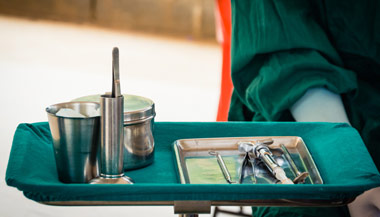Urine Flow Test
What is a urine flow test?
A urine flow test calculates the speed of urine flow over time. It may be used to check how the bladder and sphincter are working.
The bladder is part of the urinary tract. It’s a hollow muscular organ that relaxes and expands to store urine. It then contracts and flattens to empty urine through the tube that carries urine from the bladder out of the body (urethra).
The sphincter muscle is a circular muscle. It closes tightly, like a rubber band, around the bladder opening. This helps keep urine from leaking.
For this test, you will urinate into a special funnel that is connected to a measuring device. The device calculates the amount of urine, rate of flow in seconds, and the length of time until all urine has been passed. This information helps evaluate how well the lower urinary tract is working. It also helps figure out if there is a blockage of normal urine outflow.
During normal urination, the initial urine stream starts slowly. But it speeds up until the bladder is nearly empty. The urine flow then slows again until the bladder is empty. In people with a urinary tract blockage, this pattern of flow is changed, and increases and decreases more slowly. The urine flow test graphs this information, taking into account your gender and age.
Why might I need urine flow test?
A urine flow test is a quick, simple test that gives useful feedback about the health of the lower urinary tract. It is often used to see if there is blockage to normal urine outflow. Health conditions that can change normal urine flow include:
- Benign prostatic hypertrophy (BPH). This is enlargement of the prostate gland. It is not caused by cancer and often happens in men over age 50. The prostate wraps around the urethra. When it is enlarged, it can narrow the urethra and interfere with normal passage of urine from the bladder. If left untreated, the enlarged prostate can block the urethra completely.
- Cancer of the prostate or bladder
- Urinary blockage. A urinary tract blockage can happen for many reasons along any part of the urinary tract, from the kidneys to the urethra. It can lead to a urine backup. This can cause infection, scarring, or even kidney failure if untreated.
- Neurogenic bladder dysfunction. This is trouble with bladder function due to a nervous system problem, such as a spinal cord tumor or injury.
- Frequent urinary tract infections. These can cause scarring and damage in the urinary tract.
There may be other reasons for your healthcare provider to recommend a urine flow test.
What are the risks of a urine flow test?
A urine flow test is safe for most people. The test is often done in a private bathroom or procedure area.
There may be risks depending on your specific health condition. Be sure to discuss any concerns with your healthcare provider before the procedure.
Certain factors or conditions may interfere with the accuracy of a urine flow test. These factors include:
- Straining with urination
- Constipation
- Your bladder is not full of urine
- Body movement during urination
- Certain medicines that affect bladder and sphincter muscle tone
How do I get ready for a urine flow test?
- Your healthcare provider will explain the procedure and you can ask questions.
- Generally, no prior preparation, such as fasting (not eating or drinking) is needed.
- You may be told to drink about 4 glasses of water several hours before the test to be sure that your bladder is full. Don't empty your bladder before arriving for the procedure.
- If you are pregnant or think you may be, tell your healthcare provider.
- Make sure your healthcare provider has a list of all medicines (prescription and over-the-counter), herbs, vitamins, and supplements that you are taking.
Based on your health condition, your healthcare provider may request other specific preparation.
What happens during a urine flow test?
A urine flow test may be done on an outpatient basis. This means you will go home the same day. Or it may be done as part of your hospital stay. Procedures may vary depending on your condition and your healthcare provider's practices.
Generally, a urine flow test follows this process:
- You will be taken into the procedure area and told how to use the urine flow test device, called a flowmeter.
- When you are ready to urinate, you will press the flowmeter start button and count for 5 seconds before beginning urination.
- You will start to urinate into the funnel device that is attached to a regular toilet or portable commode. The flowmeter will record information as you are urinating.
- You should not push or strain as you urinate. You should stay as still as possible.
- When you are done urinating, count for 5 seconds and press the flowmeter button again.
- Don't put any toilet paper into the funnel device.
- The test will be done at this point. Depending on your condition, you may be asked to repeat the test over several days.
What happens after a urine flow test?
Generally, there is no special type of care after a urine flow test.
Your healthcare provider may give you other instructions after the procedure, depending on your situation.
Next steps
Before you agree to the test or the procedure make sure you know:
- The name of the test or procedure
- The reason you are having the test or procedure
- What results to expect and what they mean
- The risks and benefits of the test or procedure
- What the possible side effects or complications are
- When and where you are to have the test or procedure
- Who will do the test or procedure and what that person’s qualifications are
- What would happen if you did not have the test or procedure
- Any alternative tests or procedures to think about
- When and how will you get the results
- Who to call after the test or procedure if you have questions or problems
- How much will you have to pay for the test or procedure





